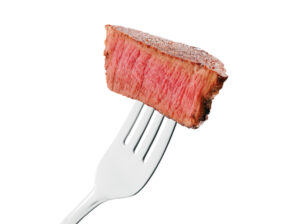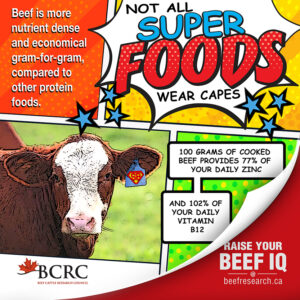Will the Real Superfood Please Stand Up?
This article written by Dr. Reynold Bergen, BCRC Science Director, originally appeared in the August 2020 issue of Canadian Cattlemen magazine and is reprinted on the BCRC Blog with permission of the publisher.

“Superfood” is a marketing (not medical or scientific) term used to describe foods with perceived health benefits because of exceptional nutritional properties. Google “superfood” and you’ll see numerous lists claiming health benefits for foods like broccoli, legumes, nuts, salmon, eggs, kale, beans, spinach, and trendy new things like acai or goji berries that marketers are launching. Animal proteins are rarely included, with the occasional exception of eggs or fish.
Meat, and particularly red meat, is often portrayed as nutritionally optional. As one example, Canada’s new Food Guide suggested that plant- and animal-based proteins are nutritionally equivalent, but recommended eating plant-based proteins more often. Like similar reports linking red meat consumption to heart disease and cancer, the new Food Guide has been heavily criticized for selective using evidence to support their recommendations.

Dietary deficiencies occur throughout the world, including Canada. 2012 Health Canada report entitled “Do Canadian Adults Meet Their Nutrient Requirements Through Food Intake Alone?” examined nutrient intakes in 35,000 Canadian men and women aged 19 years of age or older. They were asked what they had eaten in the previous day. Nutrient intakes were estimated by comparing what they ate to the average nutrient content of those foods. Protein intake was adequate for 97% of adults, but vitamin B12 and zinc intakes were inadequate for 10 to 35% of men and women, and iron intake was inadequate in 16 to 19% of women aged 19-50. Can beef play a role in addressing these inadequacies?
The University of Guelph’s Ben Bohrer recently completed a BCRC-funded project that helps answer this question. His team used publicly available data to summarize the nutrient density and nutritional value of beef, pork, lamb, poultry, seafood and plant foods. Current retail prices were collected and used to compare the nutrient costs in these different foods.
What They Did:
The Canadian Nutrient File database contains the nutritional composition of 25 beef products, 15 pork products, 6 lamb products, 12 poultry products (chicken and turkey), eggs, 11 fish products, and 15 plant products including legume vegetables (lentils, green peas, black, pinto, lima, kidney, and Great Northern beans), nuts (peanuts, almonds, cashews) and others (kale, broccoli, spinach, quinoa). The calorie, protein, fat, saturated fat, cholesterol, vitamin B12, iron, phosphorus, zinc, and sodium contents were compared among these cooked products.
Average retail costs were determined from monthly visits to three different retail stores in southwestern Ontario from December 2019 to April 2020.
What They Learned:
The report included a highly detailed comparison of each product’s purchase cost, level of each nutrient (and their costs) in both uncooked and cooked products. This article summarizes how cost-effectively beef and plant proteins can provide the nutrients of concern in the 2012 Health Canada report (protein, vitamin B12, iron and zinc).
For a person to get as much protein from plant sources as they would from a single 100 g serving of beef, they’d have to eat 160 g of nuts or 500 g of legume vegetables. Eating that much plant protein would mean consuming twice as many calories from legume vegetables (443 calories) or four times as many calories from nuts (940 calories) as from beef (235 calories). Neither plant source would provide any vitamin B12, but the 2.6 μg in beef would meet the person’s daily requirement (2.4 μg).The nuts would provide less zinc (6 mg) and the legume vegetables would provide much less zinc (4 mg) than the beef (8 mg). Both plant sources would contain more iron than beef (6 mg from 160 g of nuts and 9 mg from 500 g of legume vegetables, compared to 3 mg of iron in 100 g of beef). But fiber, phytates, and other anti-nutritional compounds mean that the iron from plant sources would be less digestible and less easily absorbed by the human body as the iron from beef.
On top of all that, 160 g of nuts would cost nearly twice as much ($4.65) and 500 g of legume vegetables would cost almost the same ($2.02) as 100 g of beef ($2.17).
What it Means:
These results will vary with price, and comparing “averages” is an oversimplification. Different nuts or legumes have different nutrient levels and prices. So do different cuts of beef or other meats. But Canada’s new Food Guide didn’t distinguish between different nuts, legumes, or cuts of beef, lamb, pork or poultry either. It only says that protein foods “include legumes, nuts, seeds, tofu, fortified soy beverage, fish, shellfish, eggs, poultry, lean red meat including wild game.”
Beef is a very nutrient dense food, particularly for vital nutrients that are most often inadequate in Canadian diets (iron, vitamin B12 and zinc). Its high nutrient density makes it an affordable source of all these nutrients for consumers, even if some beef cuts can be costly.
Grandma was right after all! A healthy, balanced diet contains fruit, vegetables, grains and meat. Beef is a good fit in Canadian diets. It may even be a superfood.
The Beef Research Cluster is funded by the Canadian Beef Cattle Check-Off and Agriculture and Agri-Food Canada with additional contributions from provincial beef industry groups and governments to advance research and technology transfer supporting the Canadian beef industry’s vision to be recognized as a preferred supplier of healthy, high quality beef, cattle and genetics.
Click here to subscribe to the BCRC Blog and receive email notifications when new content is posted.
The sharing or reprinting of BCRC Blog articles is typically welcome and encouraged, however this article requires permission of the original publisher.
We welcome your questions, comments and suggestions. Contact us directly or generate public discussion by posting your thoughts below.